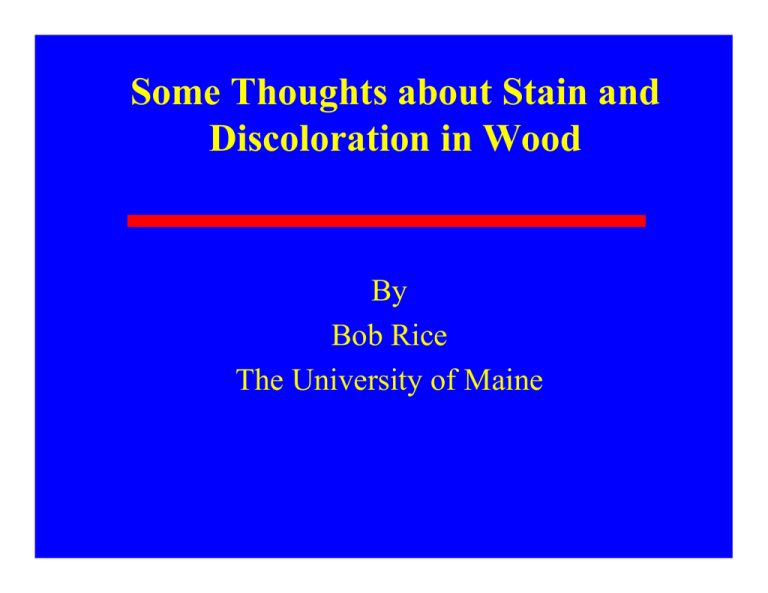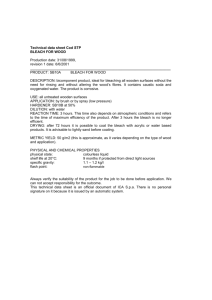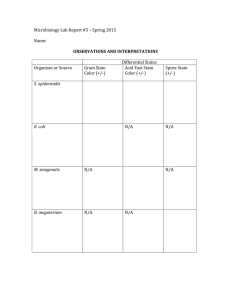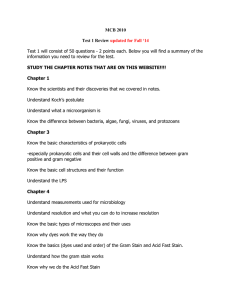Some Thoughts about Stain and Discoloration in Wood By Bob Rice
advertisement

Some Thoughts about Stain and Discoloration in Wood By Bob Rice The University of Maine Stachybotrys- Black Mold Causes of Discoloration in Wood • Fungal Stains (mold, mildew, sapstains like bluestain) • Bacterial infection (decay, rot) • Enzymatic (gray, some brown, etc) • Other (chemical, gum and resin pockets, mineral stain, iron stain ) Conditions for Mold, Stain, Decay • • • • • Must have entry site Air/oxygen Temperature (best: 65-95F) Must have water Must have food source How to Make a Bad Problem Worse • Time • Temperature • Water/water vapor Recognizing Bluestain Water and Fungi Fungus Water Activity (RH) Alternaria 0.85 - 0.88 Aspergillus 0.71 - 0.94 Cladosporium 0.85 - 0.88 Fusarium 0.86 - 0.91 Mucor 0.90 - 0.94 Penicillium 0.78 - 0.86 Rhizopus 0.90 - 0.93 Stachybotrys 0.91 - 0.94 Control of Mold, Stain, Decay • Dry wood (Average less than 22%) • Poison food source • Apply fungicide or bactericide to surfaces Surface Treatments are only intended to work for a short period of time. They are not permanent cures Fungal Spores Remain Viable Even When Dried Making Fungus Work For You-Denim Pine Denim Pine Tabletop Sigh…. Enzymatic and Chemical Stains or “is that lumber really pink…?” Enzymatic Stains • Light gray, or pink; surface may look dirty when gray • Usually seen after kiln drying • Oxalic acid will lighten or remove gray stain • Sodium Hydroxide will remove pink. Rules for kiln operators: #1 Make Beer and Whiskey With Enzymes, Not Gray Stain or Enzymatic Brown. How to Make a Bad Problem Worse • Time • Temperature • Water/water vapor Shades of Gray I Shades of Gray II Some Brown Stain is a Chemical Stain not Enzymatic • Chemical concentration required at surface which occurs during drying • Re-wet and re-dry also concentrates chemicals on surfaces and just below surfaces • The role of temperature (“Maillard” reaction) • The role of nitrogen Brown Stain Under a Microscope Also Maillard Reaction • Toast • Malted barley for whiskey • Seared meat • Self tanning products • Bread Crust Enzymatic Browning; Not Maillard Reaction • • • • • Caramel for candy Maple syrup Chocolate Fruit turns brown Oxygen and low moisture key issues. Brown Stain in Service Two Miscellaneous Cases Mineral Iron Tannate Stain Cleaning Wood Surfaces and Removing Mold Cleaners Only Remove Mold from the Surface, Not Below the Surface TSP-Trisodium Phosphate • Will not remove mildew in most cases • Cleans surfaces, removes some paints, dulls glaze • May darken some species Acids • • • • Phosphoric Oxalic (Wood Bleach) Citric Hydrochloric Phosphoric Acid • Strong wood bleach • May discolor wood • Not environmentally safe in high concentrations. • Not recommended. Hydrochloric Acid • • • • Strong wood bleach May discolor wood Weakens wood even in low concentrations. Not recommended (note pool cleaners may be solutions of weak hydrochloric acid). Citric Acid • • • • Weak cleaner May require multiple treatments Will not remove tough stains or mold Cheap and sold in increasing quantities Oxalic Acid • Strong wood bleach • May discolor wood • Takes about 20 minutes to remove stains and graying • Four ounces per gallon or five percent solution • Removes mold, mildew etc. • Stains and graying will return. More…… Disodium Peroxydicarbonate • “Deck Brightener” • Sodium percarbonate in active ingredient • Forms hydrogen peroxide when reacting with water. • Works well for mold and some stain removal • Eye and skin irritant Chlorine Bleach • Works well for mold and mildew and dirt removal • Prevents mold growth for one or two weeks • Affects lignin in wood causing degrade if strong. • Use less than one cup per gallon water • Vapors can be irritant Bob Rice 119 Nutting Hall University of Maine Orono, ME 04469



